中学英语教学案例分析
英语教学案例分析 (菁选最新4篇
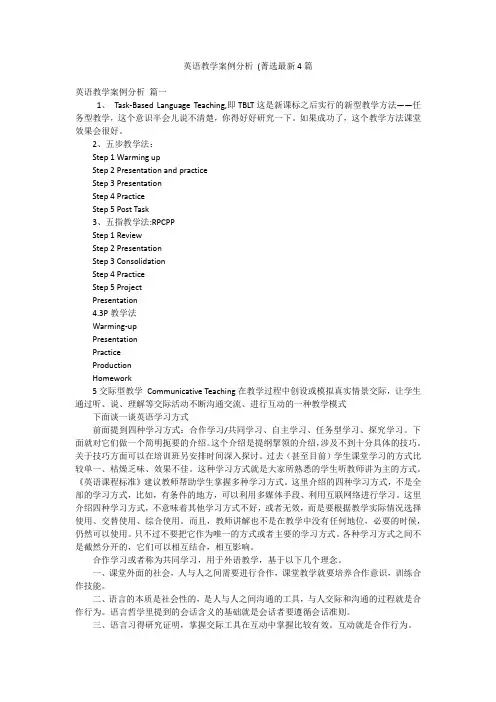
英语教学案例分析(菁选最新4篇英语教学案例分析篇一1、Task-Based Language Teaching,即TBLT这是新课标之后实行的新型教学方法——任务型教学,这个意识半会儿说不清楚,你得好好研究一下。
如果成功了,这个教学方法课堂效果会很好。
2、五步教学法:Step 1 Warming upStep 2 Presentation and practiceStep 3 PresentationStep 4 PracticeStep 5 Post Task3、五指教学法:RPCPPStep 1 ReviewStep 2 PresentationStep 3 ConsolidationStep 4 PracticeStep 5 ProjectPresentation4.3P教学法Warming-upPresentationPracticeProductionHomework5交际型教学Communicative Teaching在教学过程中创设或模拟真实情景交际,让学生通过听、说、理解等交际活动不断沟通交流、进行互动的一种教学模式下面谈一谈英语学习方式前面提到四种学习方式:合作学习/共同学习、自主学习、任务型学习、探究学习。
下面就对它们做一个简明扼要的介绍。
这个介绍是提纲挈领的介绍,涉及不到十分具体的技巧。
关于技巧方面可以在培训班另安排时间深入探讨。
过去(甚至目前)学生课堂学习的方式比较单一、枯燥乏味、效果不佳。
这种学习方式就是大家所熟悉的学生听教师讲为主的方式。
《英语课程标准》建议教师帮助学生掌握多种学习方式。
这里介绍的四种学习方式,不是全部的学习方式,比如,有条件的地方,可以利用多媒体手段、利用互联网络进行学习。
这里介绍四种学习方式,不意味着其他学习方式不好,或者无效,而是要根据教学实际情况选择使用、交替使用、综合使用。
而且,教师讲解也不是在教学中没有任何地位,必要的时候,仍然可以使用。
初中英语教学案例5篇范文
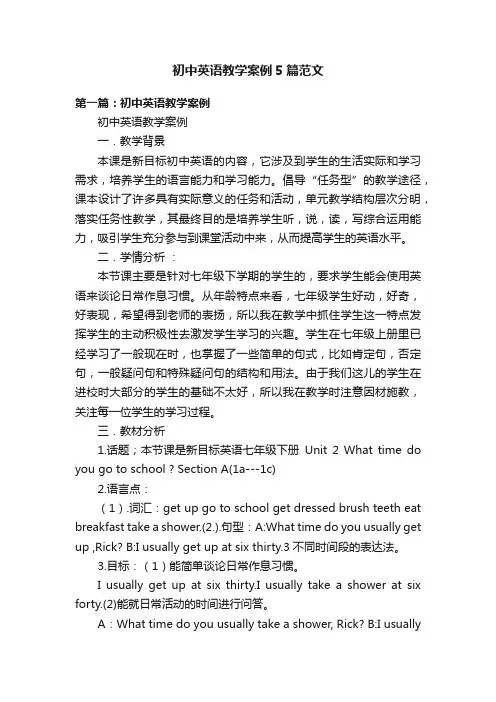
初中英语教学案例5篇范文第一篇:初中英语教学案例初中英语教学案例一.教学背景本课是新目标初中英语的内容,它涉及到学生的生活实际和学习需求,培养学生的语言能力和学习能力。
倡导“任务型”的教学途径,课本设计了许多具有实际意义的任务和活动,单元教学结构层次分明,落实任务性教学,其最终目的是培养学生听,说,读,写综合运用能力,吸引学生充分参与到课堂活动中来,从而提高学生的英语水平。
二.学情分析:本节课主要是针对七年级下学期的学生的,要求学生能会使用英语来谈论日常作息习惯。
从年龄特点来看,七年级学生好动,好奇,好表现,希望得到老师的表扬,所以我在教学中抓住学生这一特点发挥学生的主动积极性去激发学生学习的兴趣。
学生在七年级上册里已经学习了一般现在时,也掌握了一些简单的句式,比如肯定句,否定句,一般疑问句和特殊疑问句的结构和用法。
由于我们这儿的学生在进校时大部分的学生的基础不太好,所以我在教学时注意因材施教,关注每一位学生的学习过程。
三.教材分析1.话题;本节课是新目标英语七年级下册Unit 2 What time do you go to school ? Section A(1a---1c)2.语言点:(1).词汇:get up go to school get dressed brush teeth eat breakfast take a shower.(2.).句型:A:What time do you usually get up ,Rick? B:I usually get up at six thirty.3不同时间段的表达法。
3.目标:(1)能简单谈论日常作息习惯。
I usually get up at six thirty.I usually take a shower at six forty.(2)能就日常活动的时间进行问答。
A:What time do you usually take a shower, Rick? B:I usuallytake a shower at six forty.4、教具准备录音机,时钟,图片洗澡,起床,跑步,吃早餐,上学等动作的图片并将英语单词写在图片的下方。
初中英语教学案例分析集合3篇
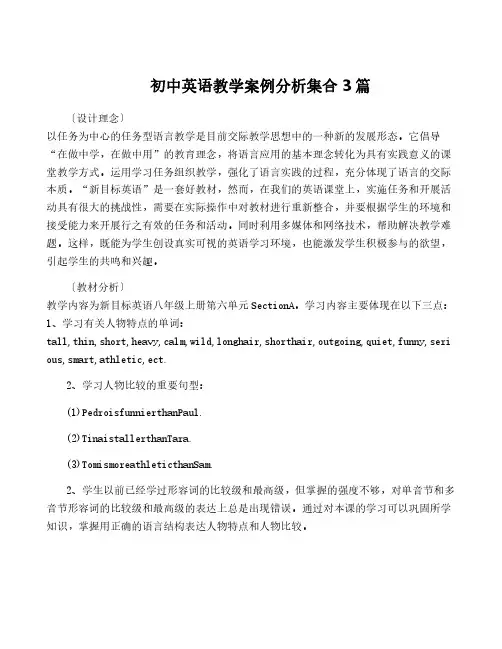
初中英语教学案例分析集合3篇〔设计理念〕以任务为中心的任务型语言教学是目前交际教学思想中的一种新的发展形态。
它倡导“在做中学,在做中用”的教育理念,将语言应用的基本理念转化为具有实践意义的课堂教学方式。
运用学习任务组织教学,强化了语言实践的过程,充分体现了语言的交际本质。
“新目标英语”是一套好教材,然而,在我们的英语课堂上,实施任务和开展活动具有很大的挑战性,需要在实际操作中对教材进行重新整合,并要根据学生的环境和接受能力来开展行之有效的任务和活动。
同时利用多媒体和网络技术,帮助解决教学难题。
这样,既能为学生创设真实可视的英语学习环境,也能激发学生积极参与的欲望,引起学生的共鸣和兴趣。
〔教材分析〕教学内容为新目标英语八年级上册第六单元SectionA。
学习内容主要体现在以下三点:1、学习有关人物特点的单词:tall,thin,short,heavy,calm,wild,longhair,shorthair,outgoing,quiet,funny,seri ous,smart,athletic,ect.2、学习人物比较的重要句型:(1)PedroisfunnierthanPaul.(2)TinaistallerthanTara.(3)TomismoreathleticthanSam.2、学生以前已经学过形容词的比较级和最高级,但掌握的强度不够,对单音节和多音节形容词的比较级和最高级的表达上总是出现错误。
通过对本课的学习可以巩固所学知识,掌握用正确的语言结构表达人物特点和人物比较。
〔教学目标〕1、谈论学生感兴趣的话题,指导学生学习有关人物特点的单词、人物比较的表达及语法知识点“形容词的比较级和最高级”。
2、学生根据班级的真实情况,采用“名人专访”、“公众投票”、“明日之星”的游戏,培养学生的想象力、自信心和合作精神。
3、通过学习本课,增强师生、生生间的相互了解和沟通。
4、培养学生的口头表达能力、阅读理解能力和写作能力。
中学英语教学实践案例(3篇)
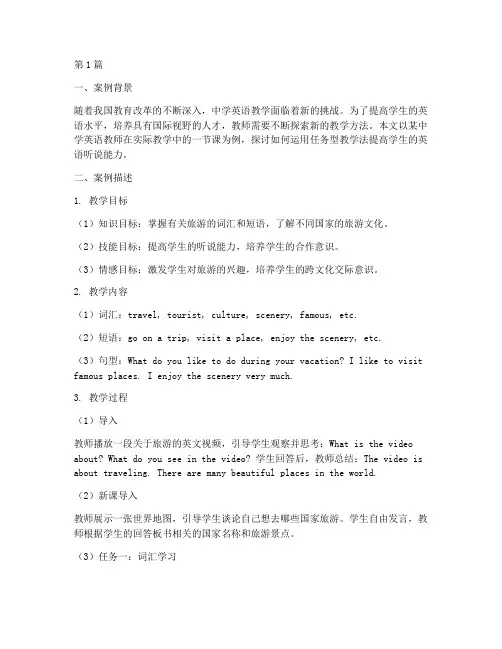
第1篇一、案例背景随着我国教育改革的不断深入,中学英语教学面临着新的挑战。
为了提高学生的英语水平,培养具有国际视野的人才,教师需要不断探索新的教学方法。
本文以某中学英语教师在实际教学中的一节课为例,探讨如何运用任务型教学法提高学生的英语听说能力。
二、案例描述1. 教学目标(1)知识目标:掌握有关旅游的词汇和短语,了解不同国家的旅游文化。
(2)技能目标:提高学生的听说能力,培养学生的合作意识。
(3)情感目标:激发学生对旅游的兴趣,培养学生的跨文化交际意识。
2. 教学内容(1)词汇:travel, tourist, culture, scenery, famous, etc.(2)短语:go on a trip, visit a place, enjoy the scenery, etc.(3)句型:What do you like to do during your vacation? I like to visit famous places. I enjoy the scenery very much.3. 教学过程(1)导入教师播放一段关于旅游的英文视频,引导学生观察并思考:What is the video about? What do you see in the video? 学生回答后,教师总结:The video is about traveling. There are many beautiful places in the world.(2)新课导入教师展示一张世界地图,引导学生谈论自己想去哪些国家旅游。
学生自由发言,教师根据学生的回答板书相关的国家名称和旅游景点。
(3)任务一:词汇学习教师带领学生学习新课词汇,并让学生用新学的词汇造句。
例如:I like to visit the Great Wall in China. I enjoy the scenery of the Yellow Mountains.(4)任务二:听说练习教师将学生分成四人一组,每组选择一个国家作为旅游目的地。
英语教学案例分析范文6篇初中
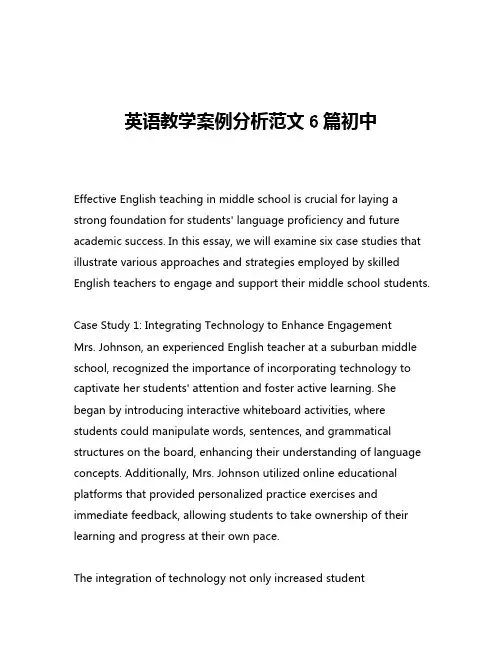
英语教学案例分析范文6篇初中Effective English teaching in middle school is crucial for laying a strong foundation for students' language proficiency and future academic success. In this essay, we will examine six case studies that illustrate various approaches and strategies employed by skilled English teachers to engage and support their middle school students.Case Study 1: Integrating Technology to Enhance Engagement Mrs. Johnson, an experienced English teacher at a suburban middle school, recognized the importance of incorporating technology to captivate her students' attention and foster active learning. She began by introducing interactive whiteboard activities, where students could manipulate words, sentences, and grammatical structures on the board, enhancing their understanding of language concepts. Additionally, Mrs. Johnson utilized online educational platforms that provided personalized practice exercises and immediate feedback, allowing students to take ownership of their learning and progress at their own pace.The integration of technology not only increased studentengagement but also enabled Mrs. Johnson to differentiate instruction and cater to diverse learning styles. Students who struggled with traditional pen-and-paper exercises found the digital activities more appealing and accessible, while those who thrived on independent learning benefited from the self-paced nature of the online resources. The result was a more dynamic and inclusive classroom environment, where all students felt empowered to participate and succeed in their English studies.Case Study 2: Fostering Critical Thinking through Literature Circles Mr. Patel, a middle school English teacher in a diverse urban setting, recognized the importance of developing his students' critical thinking skills. He implemented a literature circles approach, where students were divided into small groups and assigned different roles, such as discussion leader, connector, and literary analyst. Each group was responsible for reading a selected work of literature and engaging in collaborative discussions to unpack the themes, characters, and literary devices.The literature circles not only encouraged active engagement with the text but also cultivated essential communication and problem-solving skills. Students learned to listen actively, express their ideas clearly, and consider multiple perspectives. Mr. Patel's role shifted from a traditional lecturer to a facilitator, guiding the discussions and prompting students to delve deeper into the literary analysis.The success of this approach was evident in the students' increased confidence in expressing their interpretations and the depth of their literary analysis. Additionally, the collaborative nature of the literature circles fostered a sense of community and camaraderie among the students, further enhancing their overall learning experience.Case Study 3: Integrating Authentic Cultural ExperiencesIn a middle school with a growing population of English language learners, Ms. Garcia recognized the importance of incorporating authentic cultural experiences into her English lessons. She collaborated with the school's diversity committee to organize cultural celebrations and invite guest speakers from various backgrounds to share their stories and traditions.During these events, students had the opportunity to engage with the English language in a meaningful and contextual manner. They learned vocabulary and expressions related to the featured cultures, participated in interactive activities, and gained a deeper appreciation for the diversity within their school community. The cultural experiences also served as a platform for students to practice their speaking and listening skills in a low-stress, authentic setting.The integration of authentic cultural experiences not only improvedthe English language proficiency of the English language learners but also fostered a greater sense of inclusion and understanding among all students. The cross-cultural exchange and exposure to diverse perspectives enriched the learning environment and contributed to the overall growth and development of the students.Case Study 4: Differentiated Instruction for Struggling Readers Mrs. Nguyen, a middle school English teacher in a high-needs district, recognized the diverse learning needs of her students, particularly those who struggled with reading comprehension. She implemented a multi-tiered system of support, where she provided targeted interventions and differentiated instruction to address the individual needs of her students.For students who required additional support, Mrs. Nguyen utilized research-based reading strategies, such as guided reading, vocabulary development, and explicit instruction in phonics and fluency. She also incorporated the use of audiobooks, text-to-speech software, and graphic organizers to help struggling readers access the content and actively engage with the material.Mrs. Nguyen's dedication to differentiated instruction paid off, as her struggling readers demonstrated significant improvements in their reading abilities and overall academic performance. The individualized attention and tailored support not only boosted theirconfidence but also instilled a love for reading and learning.Case Study 5: Integrating Project-Based LearningMr. Goldstein, a middle school English teacher in a suburban setting, recognized the importance of making the English curriculum more relevant and engaging for his students. He implemented a project-based learning approach, where students were tasked with creating multimedia presentations on topics of their choice, ranging from social issues to literary analyses.The project-based learning approach allowed students to take an active role in their learning, as they conducted research, synthesized information, and utilized various technological tools to present their findings. Mr. Goldstein provided guidance and feedback throughout the process, ensuring that students developed essential skills, such as critical thinking, problem-solving, and effective communication.The project-based learning activities not only enhanced the students' engagement and motivation but also fostered their ability to collaborate, think creatively, and apply their knowledge to real-world situations. The final presentations showcased the students' diverse talents and perspectives, further enriching the learning environment.Case Study 6: Integrating Interdisciplinary ConnectionsMs. Lim, a middle school English teacher in a STEM-focused school,recognized the importance of integrating interdisciplinary connections to make the English curriculum more relevant and meaningful for her students. She collaborated with her colleagues from the science, mathematics, and social studies departments to develop cross-curricular lessons and projects.For example, in a unit on persuasive writing, Ms. Lim worked with the science teacher to have students research and write persuasive essays on environmental issues. The students not only honed their English language skills but also deepened their understanding of scientific concepts and their real-world applications. Similarly, in a poetry unit, Ms. Lim partnered with the art teacher to have students create visual representations of their poems, fostering their creativity and artistic expression.The integration of interdisciplinary connections not only enhanced the relevance and depth of the English curriculum but also encouraged students to see the interconnectedness of different subject areas. This approach helped students develop a more holistic understanding of the world around them and the role of language in various disciplines.In conclusion, the six case studies presented in this essay demonstrate the diverse and effective strategies employed by skilled English teachers in middle school settings. From integratingtechnology to fostering critical thinking, incorporating authentic cultural experiences, differentiating instruction, implementing project-based learning, and making interdisciplinary connections, these teachers have created dynamic and inclusive learning environments that support the academic and personal growth of their students. The success of these approaches underscores the importance of continuous professional development, collaboration, and a student-centered approach to English language instruction in middle schools.。
中学英语教学案例分析(1)
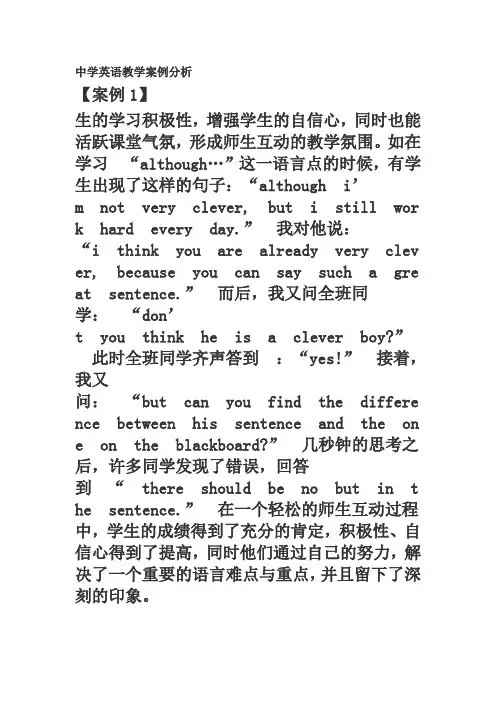
中学英语教学案例分析【案例1】生的学习积极性,增强学生的自信心,同时也能活跃课堂气氛,形成师生互动的教学氛围。
如在学习“although…”这一语言点的时候,有学生出现了这样的句子:“although i’m not very clever, but i still wor k hard every day.”我对他说:“i think you are already very clev er, because you can say such a gre at sentence.”而后,我又问全班同学:“don’t you think he is a clever boy?”此时全班同学齐声答到:“yes!”接着,我又问:“but can you find the differe nce between his sentence and the on e on the blackboard?”几秒钟的思考之后,许多同学发现了错误,回答到“there should be no but in t he sentence.”在一个轻松的师生互动过程中,学生的成绩得到了充分的肯定,积极性、自信心得到了提高,同时他们通过自己的努力,解决了一个重要的语言难点与重点,并且留下了深刻的印象。
【案例2】世界上的各种语言在一定程度上有着共同的特点,英语作为一门语言课程,与中文一样也应注重启、承、转、和。
教师在处理各个教学环节的时候,应该注意每个环节之间的衔接与过度,这样才能使整个教学过程形成一个有机的整体,避免给人支离破碎的感觉。
如,当学生准备对话表演的时候,我巡视了整个教室。
当他们准备就绪的时候,我说到:“it’s so amazing. because wh en i was walking around the classroom, i found some intere sting dialogues. do you want to share them with me?”“of course.”学生们兴奋地回答到。
初中英语教学案例分析
初中英语教学案例分析
教学案例一:话题讨论课——“健康饮食”
1. 教案主题:健康饮食
2. 教学目标:
(1)能够了解健康饮食的概念与重要性,认识食物分类及其对人体的影响;
(2)能够掌握如何选择健康饮食,了解食物的搭配和数量;
(3)能够提高学生们的口语表达和团队合作能力;
(4)能够提高学生们的实践能力和学习方法。
(1)健康饮食的概念与重要性
(2)食物的分类及其对人体的影响
(1)导入环节
教师将课程的主题告知学生,并让学生们在小组之间互相交流,在课堂后期进行讨论,且在学生之间共享自己的发言。
(2)学习活动
教师先让学生了解什么是健康饮食及其重要性,让学生自己思考,然后教师补充和讲解。
教师给学生出示一张图片,可以将贴在黑板上的图片打印出来,让学生们以小组为单位,就这些食品进行讨论;然后再让学生们汇报小组中的观点。
教师让学生自己想想食物怎么分类,然后以小组为单位讨论,让学生自己提出观点,
再由教师在黑板上归纳总结;然后教师就食物分类中的每一类食物的代表性生产和作用讲解,学生跟随着一起获得知识。
教师再出示几张食品补充类的图片,分组来讨论如何选择健康饮食和食物的搭配,并
就搭配提出建议,让学生们思考自己的所作所为,让他们反思自己的饮食习惯。
(3)总结讲解环节
教师让学生交流讨论的情况,并对本节课的学习结果进行总结。
在本节课的学习中,学生们能够充分发挥自己的思维能力,在小组内热烈讨论,提高
了口头表达能力和思考能力。
而且,通过这种方式,学生们充分体验了与他人分享知识和
团队协作的乐趣。
此外,教师通过提出具体的例子和实际操练了学生们的实践能力和解决问题的能力。
初中英语教学案例分析100例
初中英语教学案例分析100例第一例:教学目标的设置案例描述:在一堂初中英语课上,老师要求学生掌握并运用动词的过去式形式。
老师使用了多种教学方法,并设计了丰富的练习和活动。
然而,学生们在课堂上仍然存在理解和应用不够准确的问题,表现出较大的困惑。
在分析原因后,老师发现可能出现了目标设置不合理的问题。
分析: 1. 目标过于宽泛:老师没有明确指出需要学生掌握哪些动词的过去式形式,导致学生对学习的范围模糊,不知道应该重点掌握哪些内容。
2. 目标过于笼统:老师只强调学生要掌握过去式形式,但没有具体阐述应用情境,导致学生不知道动词的过去式该在何种语境下使用,缺乏实际应用经验。
3. 目标未贴近学生的实际需求:老师并未引导学生思考为什么要学习动词的过去式,以及学习过程中可能遇到的问题和困惑。
这导致学生缺乏主动性和对学习的兴趣。
解决方案: 1. 目标明确:要求学生掌握十个常用动词的过去式形式。
2. 目标具体:引导学生应用过去式形式进行对话练习,提高用动词的过去式进行语言表达的准确性。
3. 目标关联实际:通过教材中的情境对话或真实场景进行角色扮演,让学生在实际交流中学习和运用动词的过去式。
4. 目标贴近学生需求:通过小组合作学习,鼓励学生彼此讨论和解答问题,激发学生学习的主动性和兴趣。
效果评估: 1. 运用命题方式的练习,通过考试、评分等方式评估学生对动词过去式的掌握程度。
2. 通过课堂观察和学生反馈,了解学生在学习过程中的困惑和进步。
第二例:教学方法的转变案例描述:一名初中英语老师发现学生对于课堂教学内容的兴趣不高,学习效果并不明显。
通过观察和反思后,老师意识到自己教学方法单一,缺乏创新,需要进行改进。
分析: 1. 老师主要采用传统的讲授、背诵和习题训练的教学方式,缺乏互动性和趣味性,不能激发学生的学习兴趣。
2. 学生在课堂上没有多次机会进行口语表达和互动,导致口语能力得不到有效提升。
3. 学生缺乏参与感,被动接受知识,没有充分发挥自主学习和合作学习的优势。
初中英语教学案例分析5篇
初中英语教学案例分析5篇第一篇:初中英语教学案例分析初中英语教学案例分析 What's this in English?[案例背景]这个单元主要教学一些物品的名称,如:学习用品,服装,水果,家具等等。
要求学生能用下列句型进行交流。
A: What’s this in English? B: It’s a pen.A: Spell it, please.B: P_E_N, pen.本单元安排在26个字母之后,因此,字母的认读,单词的拼写,以及单词的读音也是本课的重点之一。
在课堂设计的过程中,考虑到这节课的具体情况:单词较少,绝大多数学生都已在小学学过,但是,由于我所教班级学生的英语水平比较薄弱,虽然他们在小学已经学过这部分内容,加上小学英语的要求和初中英语要求的不同,他们对知识点的掌握程度还达不到初中水平。
鉴于以上种种原因,我尝试着用让学生自己教会自己的方法来完成这节课的教学。
整节课,我设计了绘画比赛,问答学习,调查统计等几个环节,一环紧扣一环,让学生在潜移默化中自然而然地学到了新知识。
实践证明,我这样的安排不仅调动了已会的同学,让他们尝到了为人师的成就感和自豪感;与此同时,还让那些不会的同学有了更多更细心的学习机会,排除了师生之间的隔阂,让他们从自己的同龄人中学习,他们感到自然,易于接受。
这不失为本课的一大闪光点。
[案例描述]1.Objectives:a.Introduce some things in English and spell the new words to revise the letters.b.Most of the students would be able to use the article : a and an.c.New words: what, is, this, in, English, spell, it , please, a, an, jacket, pen, ruler, map, key, quilt, it's Method instruction:a..Cooperation learning : competition-----draw fourpictures(each team a picture about school things, fruit , clothes and furniture(five minutes)b.show them in class.Then the teacher asked : What's this in English? Who knows? Please hands up!Then let the students who have learnt the new words teach the others.c.Let the whole class repeat the new words several times..Pay attention to the article: a and and.Cooperation leaning: Make a survey;learn the English of the other things they draw and write down the English names beside the things they drew.Agree them to ask the students in other groups if all the students in their group don't know the words.e.Show the words they write on the blackboard by 实物投影。
初中英语教学案例分析报告范文6篇
初中英语教学案例分析报告范文6篇文档一:《利用分组合作学习法教授初中英语》背景介绍分组合作学习法在教育领域中已被广泛采用,具有丰富的教学资源、激发学生主动学习的积极性等优点。
本文以初中英语教学为例,分析了利用分组合作学习法的一个实例。
案例描述在初中英语课堂上,采用分组合作学习法,学生根据自身英语水平和学习兴趣分组,每个小组由3-4名学生组成。
教师为每个小组提供了一系列与当前课程内容相关的英语练习题和讨论题。
学生学习效果通过分组合作学习法,学生在小组内相互讨论、互相帮助,共同解决练习题和讨论题。
这种学习方式促使学生更加积极主动地参与学习,激发了他们的学习兴趣。
学生通过小组间的合作,不仅提高了语言表达能力,还加深了对课程内容的理解。
同时,通过小组合作,学生在解决问题的过程中形成了团队意识,培养了合作精神。
教师角色教师在此过程中扮演着指导者的角色,他们布置任务、提供指导,并在小组活动结束后对学生进行评价。
教师提供的指导旨在帮助学生形成良好的学习习惯和学习方法,进而提升他们的学习效果。
文档二:《通过角色扮演提高初中英语口语表达能力》背景介绍初中英语口语表达能力的提高对学生的英语学习至关重要。
在教学中,通过角色扮演的方式可以帮助学生在一个相对真实的情景中锻炼口语表达能力。
案例描述将学生分为小组,每个小组扮演一个特定的角色,比如去餐厅点餐、在商店买东西等。
教师在扮演相应的场景中的角色,与学生进行对话练习。
学生学习效果通过角色扮演,学生能够在一个模拟的情景中练习真实的口语表达。
与教师的对话练习可以帮助学生更好地理解并运用所学的句型和词汇。
此外,角色扮演还可以培养学生的合作意识和团队合作能力。
教师在角色扮演中既是引导者,也是参与者。
他们需要起到积极引导学生参与角色扮演的作用,并及时给予学生反馈和指导。
教师还可以在角色扮演活动结束后进行整体的总结和评价。
文档三:《利用多媒体教具提高初中英语听力能力》背景介绍初中英语听力是学生英语学习中的重要环节。
- 1、下载文档前请自行甄别文档内容的完整性,平台不提供额外的编辑、内容补充、找答案等附加服务。
- 2、"仅部分预览"的文档,不可在线预览部分如存在完整性等问题,可反馈申请退款(可完整预览的文档不适用该条件!)。
- 3、如文档侵犯您的权益,请联系客服反馈,我们会尽快为您处理(人工客服工作时间:9:00-18:30)。
中学英语教学案例分析(1)What things can harm the environment ?What do you think we should do to improve our environment ? )活动目的:通过列举污染源,学生更清楚当前环境的不仅如人意,保护环境刻不容缓,从而使学生增强保护环境的意识。
他们动脑筋,想办法,积极讨论保护环境的措施,在不知不觉中提高英语语言运用能力。
活动过程:T: There is much pollution all over the world now. Can you tell me what it is ?(学生很快地回答)Ss: Water pollution ; Air pollution; Noisepollution;soil pollution …etc.T: Do you know what causes water pollution ?Ss: Factories pour waste water into rivers and lakes .T: All the factories ?Ss: No .T: What factories ?Ss: Paper factories , printing and dyeing mills ,plastic factories…ect.( 学生不会用英语说“印染厂及塑料厂”,他们说中文,我说英文。
)T: What else can cause water pollution ,too?Ss: Some people throw rubbish into rivers and lakes .T: How can we help to solve this problem ?( 学生们分组讨论解决办法。
)Ss: We can advise the directors of these factoriesto stop pouring waste water into rivers and lakes .T: If they don’t accept your advice ,what else canwe do ?(学生们讨论更热烈了,过了一会儿,他们七嘴八舌地说:)Ss:1. We can write a letter to Green China about it .2. We can also ask newspaper reporters and TVstation reporters to report these factories .……T: There is a paper factory in my hometown .Itpours waste water into the river every day . Thepeople in the town drink the water of the riverevery day . They have advise the leader to stoppouring waste water into the river many times .Buthe never accepts it . Can you write a letter aboutit to the Green China ?(学生异口同声说“Yes”。
由于写作太费时间,这封信作为回家作业,请同学们写在作业本上。
)T: You have told me what causes water pollutionand how to solve this problem .You’re very clever.Thank you very much .But can you tell me whatcauses air pollution ?Ss: The smoke of factories ,the smoke given out bybuses ,cars ,tr ucks ,motorbikes …ect.T:There aren’t many factories in our city,Hangzhou .But the air is n ot good enough .Why ?Ss: Because there is much traffic .T: Can you think out a way to solve this problem?(学生们分组讨论解决方案,基础差的同学也纷纷参与,只不过在用中文说;基础好的同学在帮他们翻译。
)Ss: 1.We can plant more trees on roads .2.We can ask people not to drive their cars to work .3.We can ask people to ride bikes to work .4.We can tell people riding bikes is good fortheir health . ……T: If their homes are far away from theirworkplaces ,can they ride bikes to work ?Ss: No.T: How can we solve it ?(学生们兴致更高了。
你说一句,我说一句。
大意是:)Ss: We can ask the leader of the city to developthe public traffic. Such as adding more buses ,building underground .…ect.T: We have thought out many methods to improve ourenvironment .I will try my best to tell ourgovernment that something must be done to makeHangzhou more beautiful .Have you ever made any pollution ?Ss: Yes .T: Can you tell me something about it ?Ss: Yes .S1: I sometimes spit in public places .S2: I sometimes draw on public walls .S3: I cut down a small tree in my school in GradeOne .I feel very sorry now .S4: We sometimes throw litter on the ground in andout of our classroom .S5: I often don’t pick up rubbish in public places .…….(我乘机问全班同学下列问题。
)T: Will you spit in public places from now on ?Ss: No.T: Will you draw on public walls any more?Ss: No.T: Will you cut down trees in the future ?Ss: No.T: Will you throw rubbish in public places?Ss: No.…….(这时候,同学们情绪很高涨,他们几乎是异口同声地说:)We must try our best to make our city (ourcountry) the most beautiful one in the world .点评本案例是根据第三册第十课的pre-read拓展而成的。
1.本文所设计的问题实际上是英语课与生物课中的“环保”章节的整合。
教师让学生列举污染源,学生讲出了很多的污染源-----空气污染、水污染、土壤污染、噪音污染等等。
实际上让学生复习了生物课中刚学的“大气与健康”、“土壤与健康”、“水与健康”等的环保知识。
2. 教师让学生分组讨论如何解决这些污染问题,巧妙地运用了合作学习法,不但培养了学生探究问题和自主解决问题的能力,而且也培养了学生的参政议政的意识。
同学们以主人翁的身份,提出了种种解决方法。
解决水污染问题,他们先用劝说的办法,当此法行不通时,再借助新闻媒体的力量,最后,上告政府;解决空气污染问题,他们号召人们骑车上班。
当老师提醒他们,若家离工作地方很远,不能骑车上班时,该怎么办?他们马上想到了公交车。
他们要求政府增加公交车辆,建造地铁。
3.老师因势利导,请他们回忆一下,以前有否做过有损于环保的事情。
其实是英语课与政治课的整合。
在这么和谐,民主、激动的气氛中,同学们毫无顾忌,畅所欲言,纷纷讲述了自己以前的不文明表现。
当老师问他们以后还会做这种事吗?他们很真心地回答“No”。
自然恰当的德育渗透,起到一箭双雕的作用,使活动达到了高潮。
总之,整个过程,教师不是在“教教材”,而是在“用教材教”。
教师根据学生的实际情况和生活经验创造性地使用教材,从学生熟悉的知识入手,创建一个个与学生生活密切相关的问题情景,让学生带着问题思考,寻找解决问题的办法。
真正体现了《新课标》的精神----“在发展语言能力的同时,发展思维能力,激发想象力和创造力。
”《新课标》说;活动不应该仅限于课堂教学,而要延伸到课堂之外的学习和生活之中。
同学们回忆自己的不文明行为,作自我批评,是活动的高潮,是自我教育,提高环保意识的最有效手段。
当时,教师应该趁热打铁,利用同学们的这份热情,让同学们利用课余时间,用英语采访同年级的别班同学,让同学们在同龄人面前很自然地回忆自己的不文明行为。
然后,以此为依据,让本班同学用英语向全校同学发一份以“保护环境”为内容的倡议书。
这不但会在全校兴起一股学英语的热潮,还会使环保意识深入人心。
这是实实在在的任务型教学,体现了学中用,用中学的《新课标》精神。
让学生在实现任务的同时,感受成功,以形成积极的学习态度,促进英语语言实际运用能力的提高。
这才真正符合《新课标》的理念。
思考与探讨:1在每一次分组与讨论的过程中,如何更有效的促进上、中、下学生进行合作学习,互相帮助,使每位同学在每个活动中都有所得,尽量减少两极分化,是我们急需要解决而又难以解决的问题。
2.班额大,在分组讨论过程中,教师很难及时地对每个组进行指导。
久而久之,必定影响实际教学效果。
怎么办?3.用“真问题”组织课堂教学时,要留给同学足够的思维时间和回答问题的时间,教学任务完不成,怎么解决这对矛盾?4.水污染;空气污染已严重威胁着人类的健康。
